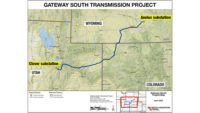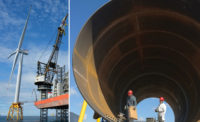Renewable generation is expected to account for about two-thirds of the 24 GW of energy capacity the U.S. added in 2016, and industry observers don’t expect alternative-energy additions to fall in coming years, despite changed political winds. “Solar and wind are the least cost power in many markets,” says John Woody, renewable-energy senior director at developer NRG. Customer demand is driving the market, he says.
Even in the low-cost natural-gas environment, which keeps power prices low, NRG’s utility-scale wind and solar generation can compete on price, but renewables have an added advantage to hedge against future cost hikes in fossil fuel-fired generation, Woody says. Commercial and industrial customers can forecast power rates over the long term in deals structured without price escalators, he notes, adding, “It’s a huge value driver.” Federal production and investment tax credits that have supported renewable construction over the past decade reduced the price of renewable sources, but development costs have dropped dramatically and will continue to over the next five years as tax credits are phased out, Woody says. NRG’s analysis shows prices for renewable power will continue to decline.
While the tax credits are important policy mechanisms and have broad support because they create jobs, there are other drivers, such as a broader investor base to cut development costs and a customer base that supports sustainability goals over government policies, says Woody. Proponents say the new industry is creating jobs and made-in-the-USA infrastructure. “This is not an environmental movement. It’s an industrial movement,” says Jim Lanard, CEO of offshore wind developer Magellan Wind. A Gulf Coast firm with offshore oil experience constructed platforms for the first U.S. offshore wind farm now operating off Rhode Island.
Economics
Offshore wind, while more expensive than onshore wind and solar, was able to compete economically on the 30-MW offshore Rhode Island project, which now is operating. Last month, the Long Island Power Authority approved another wind farm, which is to be sited off eastern Long Island, N.Y., and would be three times larger than the Rhode Island plant. In granting approval, LIPA cited the area’s limited access to traditional sources and noted that offshore wind occupies a smaller footprint than other renewable resources. Deepwater Wind, which also built the Rhode Island project, proposed the $740-million wind farm.
Still, offshore wind prices are dropping quickly, with a recent tender in Europe coming in at 5.5¢/kwh. European developers expect to see cheaper prices and more opportunities in the U.S. as the supply chain in this country matures as in Europe. The Europeans have either won federal offshore leases or bought them from others. Norway’s Statoil won a U.S. lease off the coast of Queens, N.Y., in December, eyeing Gov. Andrew Cuomo’s (D) plan for 24 GW of capacity to be built offshore by 2030.
Italy’s Toto Holdings has proposed a 750-MW project off the coast of Maryland through its US Wind unit. State regulators in March will review that proposal and a 120-MW Deepwater Wind bid. Set to choose one of those projects in May, they hope to build under a state law that limits the ratepayer cost to $1.25 a month and requires projects to create enough jobs to offset the higher wind-farm power cost.
Denmark’s DONG Energy in 2015 acquired development rights to a 300-sq-mile lease off the Massachusetts coast and has teamed with a New England transmission firm to build a utility-scale wind farm that could grow to 2,000 MW. The state has the largest offshore wind commitment—1,600 MW over 10 years—under a law signed by Gov. Charlie Baker (R).
The U.S. government will offer its seventh offshore-wind commercial lease—off the coast of North Carolina—on March 16. The sale underscores the growing market demand for renewable energy and strong industry interest, the Obama administration said in mid-January, noting nine qualified bidders. Backers are satisfying objections to view obstructions by moving sites over the horizon line, says Lanard.
States Set Pace for Renewables
States are leading the charge through renewable-energy portfolio standards or access to resources. Texas Gov. Rick Perry (R), President Donald Trump’s pick to lead the U.S. Energy Dept., has managed the nation’s largest land-based wind power growth. Perry supports an “all-of-the-above” energy strategy, despite Trump’s promise to push fossil-fuel and coal sources. Texas has installed 18,000 MW of onshore wind energy, which produces about 15% of the state’s power. Of 29 states with renewable-energy standards, Hawaii’s is highest, at 100% by 2045.
Renewable-energy development is a states’-rights issue, observers say. For example, New York and California will not likely allow another coal-fired plant, while the economics of lower-cost fuel have driven firms such as NRG to convert coal plants to natural gas. Further, strong wind resources have pushed even midwestern Republican states to develop massive onshore farms.





